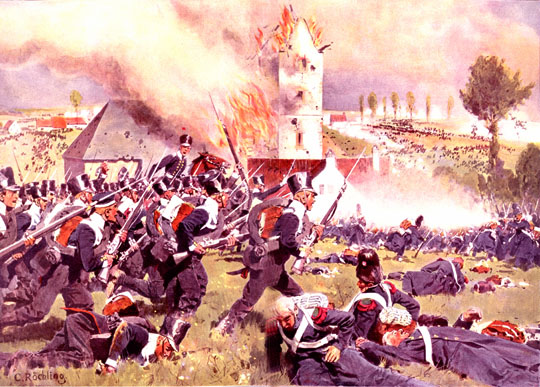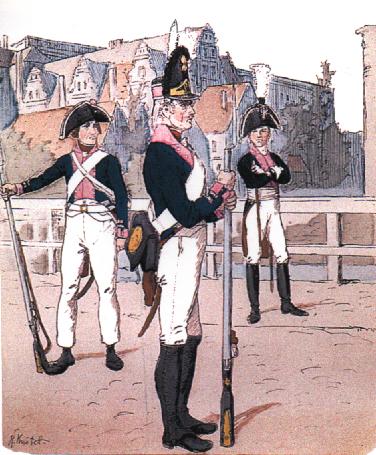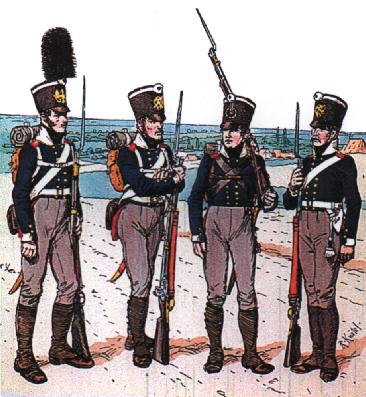
Prussian Line Infantry

Prussian Infantry attacking Placenoit, 1815
Organisation
1806 - Each infantry regiment had 3 Musketeer battalions. Each battalion had 5 Musketeer and 2 Grenadier companies. However, the Grenadiers were usually detached and formed into composite Grenadier battalions of 4 companies each. Each battalion had a full strength of around 700 men and officers.
1808 - After Prussia's spectacular defeat in the 1806 campaign, reforms were instituted in earnest. Infantry regiments were reorganised into 2 Musketeer and 1 Light (also called Fusilier) battalions. Each Musketeer battalion had 4 Musketeer companies and 2 Grenadier companies. The Light battalion consisted of 4 companies. The practice of detaching the Grenadier companies and forming them into composite Grenadier battalions was continued. Each battalion had an average strength of around 800 officers and men.
1815 - In October 1814, the 6 composite Grenadier battalions were formed into 2 Grenadier regiments - named the Kaiser Alexander and Kaiser Franz Grenadier Regiments (after the Russian and Austrian emperors) respectively. Also, a number of reserve formations were absorbed into the line as regiments numbers 13 to 32.
Uniforms
1806 - The illustration below shows the basic Prussian infantry uniform at the time of the 1806 campaign. Headgear for Musketeers was a black bicorne with white edging. The plume colour varied with the regiment. The centre figure in the illustration below wears the Grenadier cap (all Grenadiers wore white plumes). The coat was dark blue and pants were either white or straw-coloured. Regimental facing colours were worn on the collar, cuffs, shoulder straps and lapels. Turnbacks were red for all regiments. Click here for a list of regimental distinctions in 1806.

L-R: Musketeer, Grenadier and Officer - 1806. Knoetel print.
1808 - The illustration below shows the new-style Prussian uniforms. Headgear was a black shako edged white (privates) and gold (officers and NCOs). The pom-pom was white with a black centre. The tall plume shown on the extreme left hand figure was only worn on parade. On campaign, the shako was usually covered with a black oilskin. The coat was dark blue and pants were grey. Facing colours were worn on collar, cuffs and shoulder straps. The turnbacks were red for all regiments. Equipment straps were white for Grenadiers and Musketeers, black for Fusiliers (Light infantry). Click here for a list of facing colours in 1808.

L-R: Musketeer with parade plume, Musketeer, Fusilier, Musketeer NCO - 1808 dress. Knoetel print.
All illustrations courtesy of Uniformology.
1815 - The 2 new Grenadier Regiments had the following distinctions - Kaiser Alexander - poppy red collars and cuffs (with dark blue cuff flap). White shoulder straps and yellow buttons. Kaiser Franz - poppy red collars, shoulder straps and cuffs (with dark blue cuff flap). Buttons were yellow.
(For uniforms of the new line regiments 13 - 32, please refer to the section on Prussian Reserve infantry.)
Sources:
Peter Hofschr÷er and Bryan Fosten: Prussian Line Infantry (Osprey Men-at-Arms)
Philip Haythornthwaite: Uniforms of Waterloo
Liliane and Fred Funcken: Historische Uniformen
[an error occurred while processing this directive]